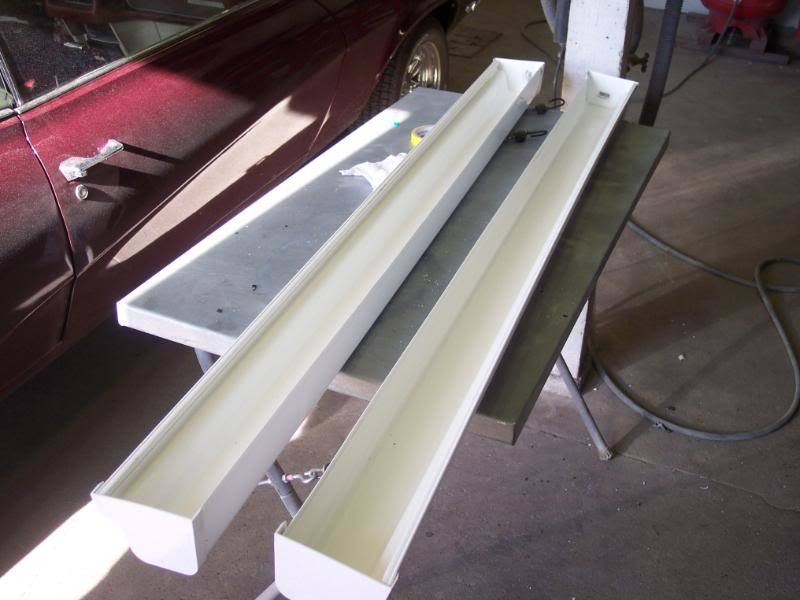I don't think it needs to be black, it just needs to keep light out. Light is what allows the algae to grow. Painting it white or silver to help reflect light not absorb it as heat and it will help keep it cooler.
Navigation
Install the app
How to install the app on iOS
Follow along with the video below to see how to install our site as a web app on your home screen.
Note: This feature may not be available in some browsers.
More options
You are using an out of date browser. It may not display this or other websites correctly.
You should upgrade or use an alternative browser.
You should upgrade or use an alternative browser.
DIY Thread - Let's see your "Inventions".
- Thread starter Eznet2u
- Start date
The heat is a down side of this, but it needs to be black to keep the algae from growing in the water
I don't think it needs to be black, it just needs to keep light out. Light is what allows the algae to grow. Painting it white or silver to help reflect light not absorb it as heat and it will help keep it cooler.
VERY much IS an invention and an excellent one at that. You did a Great job!Post #221 We went to the store to pick up a 3 or 5 gallon waterer a few weeks ago thinking they would be no more than $10 or so. WRONG!!! $40-$60 EACH. I told my wife I could make one. It doesn't hang, but it's really simple. Start with a 5 gal bucket, drill a hole in the lid. I used 1" so the water hose would fit in.Keep trying to post the pictures, because that sounds like a great waterer, and I'm not alone in being more of a "visual" learner.

Next, drill a hole on the side of the bucket, near the top. However far down this hole is from the top of the lid will be the water level in the waterer. I used a 3/32 bit, but probably shoulda used a 1/4" bit because I had to make it a bit bigger.
The bottom of a 30gal drum works good for the base. Don't throw the rest of the barrel away, turn it upside down and it becomes a nice trash barrel.
place the 5gal bucket upside down in the 30gal drum bottom. Mine is on top of a 2" tall brick to help keep debris out. When you turn it upside down, there is very little spillage because the holes a pretty small and you don't have to do it super quick like the 5 gallon drinking bottles on the fountains. You don't even have to be kinda quick.
The stuff on the 5gal bucket is just mud from filling it up. Not chicken poop. Don't konw if this is an invention, but it's extra easy and costs about $0.
 And I LOVE the cost!
And I LOVE the cost! 
Highcotton
Southern Chickens
- Mar 18, 2013
- 1,746
- 115
- 206
Highcotton
Southern Chickens
- Mar 18, 2013
- 1,746
- 115
- 206
I like to use those for filling bird feeders. The cap can be removed and you can scoop tthe seed and use the hole for the cap as a funnel.
Highcotton
Southern Chickens
- Mar 18, 2013
- 1,746
- 115
- 206
Highcotton
Southern Chickens
- Mar 18, 2013
- 1,746
- 115
- 206
That is a good looking feeder.I like your range feeder design. I'm going to have to think about making one like it.
Highcotton
Southern Chickens
- Mar 18, 2013
- 1,746
- 115
- 206
Thanks fo rthe link.
Highcotton
Southern Chickens
- Mar 18, 2013
- 1,746
- 115
- 206
Thanks for the info.This PDF is for rainwater collection systems, but on about page 9 it describes a really straighforward way of diverting debris from your collection device.
www.bcd.oregon.gov/pdf/3660.pdf
Not sure it would be ideal for this purpose (deals more with all the crud that comes off your roof when it first starts to rain), but who knows...
Matt Jarvis
Eugene, Oregon USA
I like the feeder, too. Would it work in a pen or coop mounted to the wall (without auto-water ~ I have to carry my water out to the pen.) I just have (2) 12-14" little troughs mounted outside and they don't like to take turns, especially in the morning! I think we need something l...o...n...g...e...r...
 so they can all have some at the same time. Most of it ends up on the ground.
so they can all have some at the same time. Most of it ends up on the ground.



Last edited:
New posts New threads Active threads
-
Latest threads
-
-
-
-
-
Impacted and/or Sour crop treatment
- Started by Winderdear
- Replies: 4
-
-
Threads with more replies in the last 15 days
-
-
-
-
Chicken Butt Emergency ‼️ Please Help!
- Started by urlocalcrazychickenlady
- Replies: 71
-
-
×




